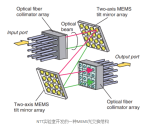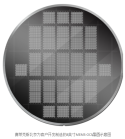MEMS Photonics for AI Datacenters.
Cyrelix Beijing successfully piloted MEMS-OCS, achieving a breakthrough in high-performance optical
Recently, the MEMS-OCS (Optical Circuit Switch, i.e., optical link switching device) manufactured for a customer by Selex Microsystems Technology (Beijing) Co., Ltd. (hereinafter referred to as "Selex Beijing"), a wholly-owned subsidiary of Selex Semiconductor, passed customer verification and received a purchase order from the customer, marking the start of small-batch trial production of the first batch of MEMS-OCS by Selex Beijing.
MEMS-OCS is a micromirror array that directly switches and schedules optical paths based on optical signals, without the need for electrical signal relays. The input optical signal is collimated to the first rotating micromirror, reflected by the second micromirror, and then directed to the target output end and back into the optical fiber. The micromirrors are tilted by integrated electrostatic or magnetic actuators. Adjusting the angle directs light to different channels, opening or closing the optical path.

As AI data centers continue to grow their demand for high-speed optical modules, upstream optical device demand is also exploding. In traditional CLOS topologies, the backbone layer of data center networks typically utilizes electronic packet switches (EPS), which perform multiple conversions between electrical and optical signals. These switches consume significant power, leading to data latency. Furthermore, data center deployments require the pre-deployment of a massive backbone layer, otherwise complete rewiring is necessary, resulting in significant capital expenditures.
All-optical switching, as an alternative to electronic switching, enables more efficient data transmission. All-optical networks have three different switching technologies: optical link switching (OCS), optical burst switching (OBS), and optical packet switching (OPS).
The development of MEMS-OCS involves knowledge in multiple fields such as optics, mechanics, electronics, and thermals, and requires a balance between optical path loss, switching speed, and mechanical stability. At the same time, the design and control of large-scale NxN arrays place extremely high demands on signal synchronization, which must be guaranteed to be stable and reliable during millions of mechanical movements. The wafer processing, surface coating, and micromechanical structure release processes of MEMS-OCS must all be highly precise and batch-stable. Any minor defects may be magnified in production and become a hidden danger of reduced yield. For this reason, my country has previously lacked the design and large-scale manufacturing capabilities of MEMS-OCS, and the explosive demand for data computing power in the optical switching field has been difficult to meet.

